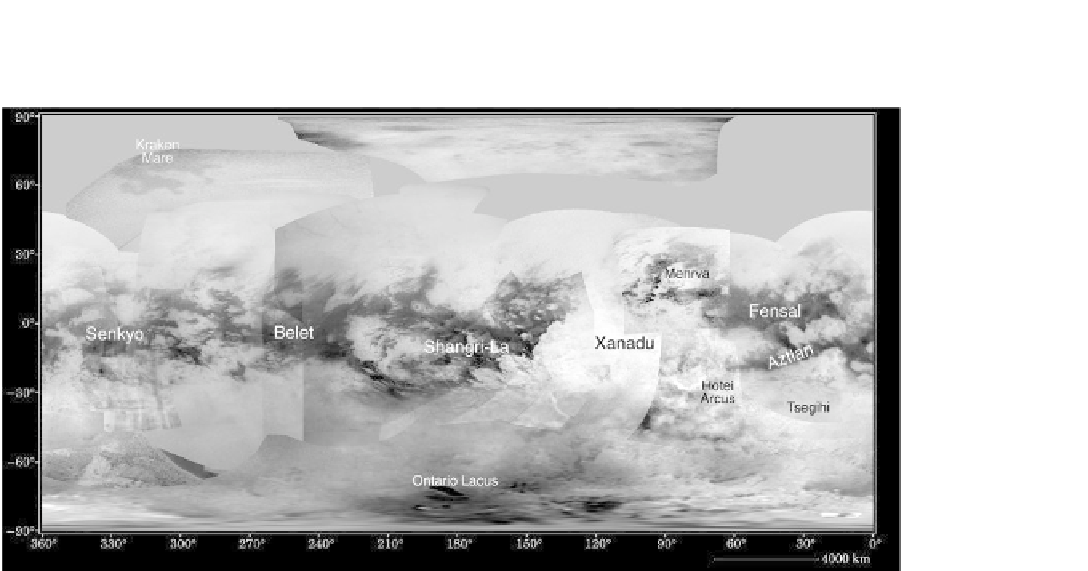Geology Reference
In-Depth Information
Figure 9.4. A mosaic of Cassini images of Titan with some of its prominent place names; most of the radar-dark patterns in the equatorial
region are
fields of linear dunes; the scale bar applies to the equatorial zone (NASA PIA11149).
until the twentieth century. In 1944, the Dutch-American
astronomer Gerard Kuiper identified methane on Titan,
which initiated speculation on the various chemical reac-
tions that might be taking place in its atmosphere.
The presence of extensive clouds was well established by
the time the Voyager spacecraft arrived. Voyager scientists
hoped that the clouds would be broken and sufficiently
scattered to allow glimpses of the surface. Such was not
the case, and the Voyager pictures are disappointingly
bland, showing a relatively uniform orange
-
brown sphere
with only hints of variations in the clouds. Limb views,
however, showed layers in the atmosphere that are thought
to be smoglike photochemical hazes. Later, Cassini
'
s radar
and infrared imaging system provided maps and moderate
resolution views of Titan
'
s surface (
Fig. 9.4
).
Nitrogen is the main component in Titan
Following the Voyager
flybys, there was speculation on
Titan
s surface processes and overall geology. All three
states of methane seemed to be possible in the current
environment, and it was suggested that methane gas and
other molecules in the atmosphere condense to form
clouds, snow, and rain, leading to rivers and lakes of liquid
methane that could erode solid ice on the surface. Wind
processes were thought to result from the dynamic atmo-
sphere that could entrain small ice particles. These poten-
tial surface processes and the chemical reactions, as
shown in
Fig. 9.5
, were discussed by planetary scientist
Jonathan Lunine (
1990
).
The successful descent and landing of the Cassini
-
Huygens probe in 2005 yielded an enormous wealth of
data on Titan
'
s atmosphere and surface. Measurements of
wind speeds began at 150 km above the surface and were
recorded at more than 100m/s. As the probe descended, it
was buffeted by
fluctuating winds resulting from vertical
shear; near the surface, winds were determined to be a few
meters per second, well within the range for aeolian pro-
cesses. Huygens
'
s atmosphere,
along with methane, hydrogen, and other carbon
'
nitrogen
components. It may be that, when Titan
first formed, meth-
ane and ammonia ices were caught up in the accreting mass.
With heating and subsequent chemical differentiation, these
compounds were released from the interior, forming an
early-stage atmosphere. The action of sunlight on the
ammonia released the nitrogen and allowed the escape of
most of the hydrogen into deep space while methane
remained on the surface. Calculations show that some of
the methane evaporated and was dissociated by sunlight.
The products recombined to form complex organic chem-
icals, resulting in an orangish smog.
-
s Gas Chromatograph Mass Spectrometer
measured not only the chemistry of the atmosphere but also
the surface materials after landing, while the Descent
Imager/Spectral Radiometer obtained images of the landing
site. As the probe touched down, engineering data
enabled the physical properties of the surface to be eval-
uated; although the first descriptions of it were as a sort of
“
Titan mud,
”
later analysis suggested the presence of dry,
'


